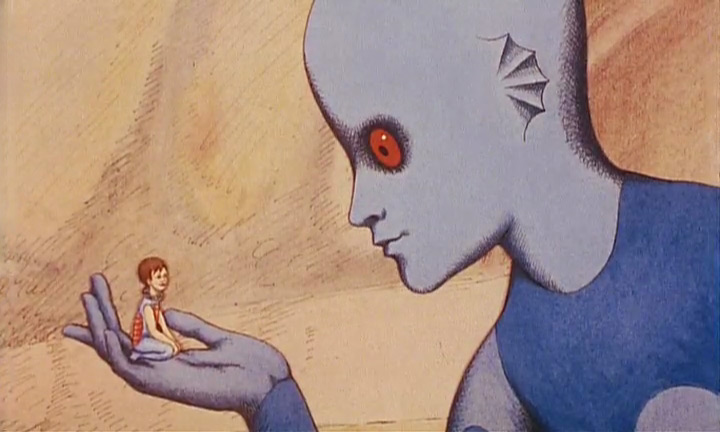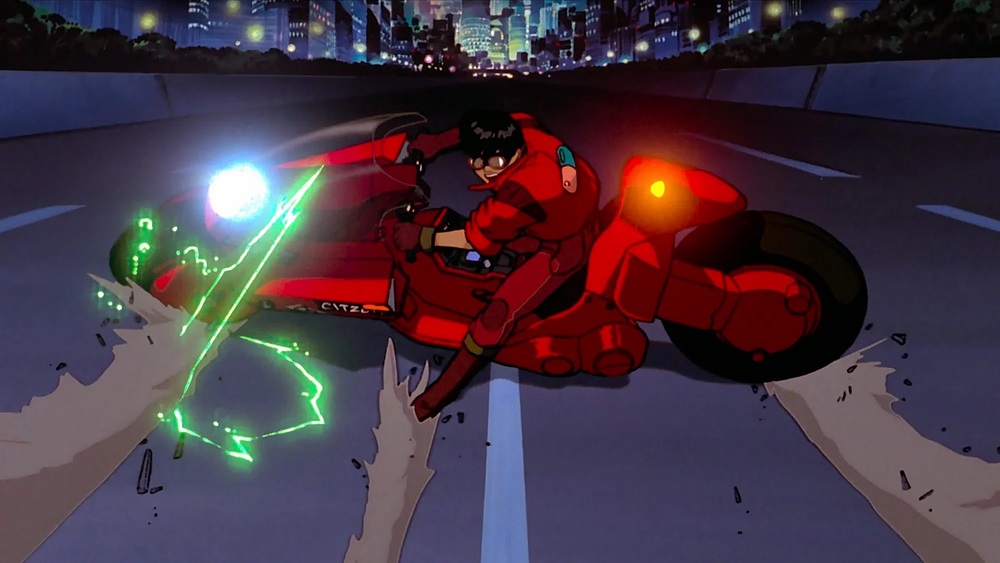
Psychedelic animation, a jazz-laden soundtrack, and a thought-provoking plot. The film ‘La Planete Sauvage’ or ‘Fantastic Planet’ is one of the most interesting films I have ever encountered. On the surface, it is a story of giant alien-like creatures, Draags, and small human-like creatures, Oms. The two species live together in constant conflict on a planet called Ygam. It all sounds very bizarre, and to be fair it is. But trust me, ‘La Planete Sauvage’ is much more than some weird, animated film. It is a story of oppression, war, and the possibility of world peace, all themes that relate to life during the film’s inception and today.
Background
‘La Planete Sauvage’ was adapted from the French science fiction novel ‘Oms en serie’, written in 1957 by Pierre Pairault. The word Om is actually a play on the French word for man, “homme”, and interestingly enough, these creatures take on the appearance of mankind. Directed by Rene Laloux, the film began production in Prague in 1968. Due to the Soviet invasion of Czechoslovakia, however, they were forced to pause for around a year. Production resumed in Paris until its release at the 1973 Cannes Film Festival. Here, the film won top prize for best feature film and went on to become an animated classic.
Storyline
Upon watching the film for the first time, I realized there was much more to appreciate than the animation alone. Although the storyline is somewhat dry, it tells an interesting and thoughtful tale. The story follows the life of the protagonist, an Om known as Terr. It begins when he is a child, separated from his mother and taken in by Draags as a pet. We see him grow, learn, and eventually, attempt to revolt. The story seeks to determine whether it is possible for the Oms and Draags to coexist, which is heavily reminiscent of the Soviet Invasion of Czechoslovakia, as well as current and recent conflicts. While others have speculated about the story’s relation to animal rights or totalitarianism, I had a slightly different reaction. These two explanations are plausible, but I think the film explains the importance of balance and finding a common ground. The two species offer to each other what they themselves lack, similar to the idea of Ying and Yang. For much of the story, they focus on each other’s differences, something that nearly drives them both to destruction. This idea of coexistence and peace is also heavily akin to the counterculture movement of the 60’s and 70’s. Additionally, the film somewhat revolves around spirituality, found in a bizarre meditation practiced by the Draags. This meditation has some rather psychedelic, transcendental implications, also reminiscent of the period. These creative decisions help make this film simple yet profound, seemingly telling two stories at once.
Animation
I came across this film while scrolling on social media, and was immediately taken aback by the animation style. Roland Topor, the film’s art director and screen-play writer, utilized a method known as paper cut-out animation for the illustrations. This method involves slicing and moving images under a camera frame-by-frame. It is far less labor intensive than producing thousands of illustrations, and was extremely popular among smaller studios in the late 1960’s. ‘La Planete Sauvage’ has a rather monochromatic, or tonal color scheme, with few contrasting colors. This adds to the overall moodiness of the film, and helps create somewhat of a dark and mysterious atmosphere. The color of the Draags is interesting in itself, as their pale blue hue and bright red eyes stand out amongst the film’s organic, tonal palette. This infers, in a way, that they are out of place or disconnected from their natural environment, and also suggests that they are incapable of coexistence. The Oms’ humanlike appearance made them extremely relatable, and I often found myself watching from their perspective. This sliver of relatability allows for the rest of the design elements to be completely abstract, giving viewers a single strand of reality to cling to. Like the storyline, naturally, the film’s animation has some psychedelic influence as well. From the plants and creatures found on Ygam, to the depiction of the sacred meditation, this influence is prevalent throughout. The colors used, the vintage style of animation, and the cultural influences found in its design, all make ‘La Planete Sauvage’ a true work of art.
Soundtrack
Last but certainly not least, is the film’s soundtrack. A strange, ethereal, and beautiful mix of jazz and bizarre sound effects. This music helps give the film an extremely unique vibe and adds so much to the storyline itself. Consisting of 25 different songs, the soundtrack was clearly designed with the screenplay in mind. It somehow manages to take the viewer on a journey of its own, both accentuating the content of the film, and adding content of its own through the mood it invokes. The music lines up impressively well with each scene, correlating notes with shifts in action or dialogue. The futuristic, ethereal sound effects incorporated behind the jazzy and often hypnotic music help create a relaxing but otherworldly atmosphere, and definitely takes on some psychedelic influence as well. While it is not technically a part of the soundtrack, the film is originally in French. Although there is a dubbed version available, I watched the original. Since I was forced to rely on subtitles, the film had a similar feel to watching a silent movie, which honestly added to the otherworldliness even more.
From its thought-provoking plot, to its psychedelic animation and jazz-laden soundtrack, this film has it all. It is currently available for streaming on YouTube and HBO MAX, and I would strongly recommend checking it out. Whether you are a fan of art, jazz music, foreign films, or the French language, this film is for you. Thanks for reading!








